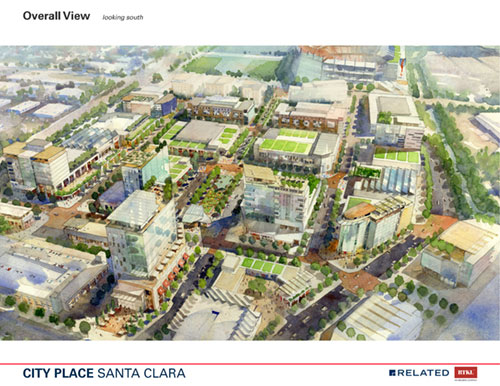
From La Jolla to Jersey City, “walk-able urbanism” – aka New Urbanism – is the hottest thing going in municipal planning. And last week’s City Council study session offered what amounted to a tutorial in New Urbanism, from the two developers that are proposing projects that would be transformative for the City of Santa Clara: Montana Property Group-Lowe Enterprise’s Centennial Gateway and Related Companies’ City Place Santa Clara.
New urbanism is a reverse of post-WWII suburbanism. It’s universally accessible public spaces and an orientation toward mass transit. It’s diverse neighborhoods, mixed-uses, pedestrian-friendly streetscapes, and walk-able local retail. Its designs honor local history, climate and culture.
But while it’s a lot like traditional cities, today’s urbanism also places a high priority on environmentally sensitive construction and energy efficiency. And it seeks balance between suburbia’s oceans of parking lots and serpentine freeway interchanges, and midtown Manhattan-style traffic gridlock.
“It’s a traditional downtown,” is how Related California President Bill Witte described it for a packed house at last week’s Santa Clara City Council study session.
“It’s a place where people of all ages, all walks of life would come to shop, or to simply hang out. Public spaces are as important as anything else in the environment. And it will be created specifically for a place, specifically for a community.”
So what will New Urbanism look like on Santa Clara’s Northside?
The first step will be Montana-Lowe’s Centennial Gateway on about nine acres of land facing Tasman Blvd. The proposal includes a hotel, office space, entertainment, retail and dining that includes a Joe Montana-branded restaurant. Montana-Lowe aims to complete the project in time for the 2016 Super Bowl L.
“The trend today is for stadiums is to integrate into the environment,” Montana partner Kurt Wittek explained. “They become destinations in their own right, creating a critical mass for entertainment that people will take advantage of – not only on game days but the rest of the year.”
“We’ve spent many hours meeting with Related to build our site plans together,” said Montana Property Group founder and football legend Joe Montana. “We’re asking you to let us go ahead with this application so hopefully we can make that Super Bowl. You wanted it and it is coming. And with it come people from all over the globe. We believe our project will enhance their experience while they are here. “
The second piece of the new neighborhood will be Related’s City Place Santa Clara, a four-phase development of 215 acres that currently house the Santa Clara municipal golf course, tennis club, and BMX track. The site was formerly a landfill, dating back to the 1930s.
City Place’s first phase would be the 89 acres adjacent to the Montana-Lowe development on Tasman. It will comprise an entire neighborhood of one- and two-story shops, markets, entertainment venues and restaurants around a central core of park and community space. Larger stores (including department stores), 4-to-14 story office buildings, a nine-story hotel, and five-story residential buildings will surround that central core.
The developer has set down some core principles for City Center that will guide all four phases of the development, explained Related’s Principal Field Architect for the project, Nate Cherry of the RTKL design firm.
The first principle is urban character and identity, said Cherry. Tasman Blvd. and Centennial Rd. need to ‘announce’ the destination with wide sidewalks and visuals that clearly identify Santa Clara’s “brand.”
Next, the area needs easy access and circulation, with at least three access points on Tasman. Streets must be walk-able, with short blocks that make for successful retail as well as adequate ‘back of house’ access for things like deliveries.
Finally, the different uses must be integrated to maximize use of parking space – as well as ensuring that parking doesn’t block circulation. Further, integration is essential for creating self-sustaining social and economic synergy with the Santa Clara Convention Center, Techmart, Great America and the other hotels and restaurants in the area.
None of this is without challenges however.
A big one is that of building on landfill, Witte told the Council Study Session last week. Related’s design incorporates building on a platform to ensure structure stability above the landfill. “With the quality of the environment we want to build there, we can’t deal with the issue of differential settlement that has plagued other landfill development projects,” he explained.
“We have a good handle on the parameters and the magnitude and cost of development,” he continued. “While there are challenges, the regulators are very enthusiastic about commercial development on landfill. On the economic side we’ve completed very detailed studies for all the uses we are considering.” Witte also noted that Related is talking with state regulators about ways to add residential units, including possibly above street-level stores.
A second challenge is finding enough access points to the development to avoid bottlenecks in the area. This will be the subject of continuing discussion as the project moves forward.
Despite the challenges this project is one-of-a-kind, said Cherry, “because there are very few places you have this kind of tie, this kind of partnership, this kind of enthusiasm, this kind of city staff.” It’s also unique because the city owns most of the land – putting the public good and public access at the heart and center of the project.
The city will begin working on ground leases soon, according to City Manager Julio Fuentes, aiming to have term sheets by early 2014. Following that work will begin on the Environmental Impact Reports (EIRs). Residents can expect many community meetings and public hearings on the projects in the coming year.
“You have made us feel incredibly comfortable here,” said Witte. “You’re going to see a lot of us over the next months and years.”





